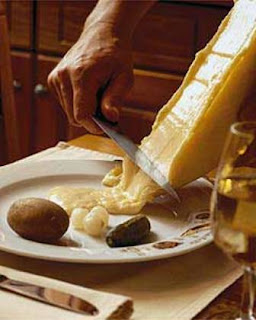Raclette is
very appealing during these winter months. The coziness of sitting around the
table, together with family and friends, drinking, grilling and cooking our food
in a relaxed dining environment; what better way to spend several hours on a
cold winter evening.
Raclette is a type of cheese and also the name of the
Swiss dish that is based on heating up cheese and then scraping off the melted
cheese. The origin of the name raclette comes from the word 'racler' which translates
to the act of scraping the melted cheese.
Traditionally, when making raclette, half a wheel of
cheese is heated and the melted cheese is scraped onto potatoes, layer by
layer. The 3 kg (6 lbs) half wheel of raclette cheese is still used today when
the dish is served for a larger group (15+ persons).
Raclette cheese is usually accompanied by small potatoes,
gherkins, pickled onions and dried meat, such as Prosciutto and viande des
Grisons.
The raclette machines used today usually have a grill
above the heating element and little trays below. This lets you grill meat,
fish and vegetables on the top grill while the raclette cheese melts in the
trays below. There is a variety of raclette machines available today, that can
be purchased and/or rented from your local cheese shop.
Raclette cheese was first made in the Swiss Alps in the
southwestern area of Valais. When
this cheese is heated it has a very creamy consistency and melts without
separating due to the cheese's balanced fat content.
Today, there is a wide selection of raclette cheeses
available for every taste from mild to strong. This is the advantage of
grilling individual portions as opposed to using half a wheel of only one
particular cheese. A variety of raclette cheeses can be pre-sliced to sample
such as; a classic raw milk Swiss Bagnes raclette, a French white wine
raclette, goat-milk raclette, sheep-milk raclette, wood-smoked raclette,
raclette with pepper corns, raclette with mustard seeds, etc.
Vegetables and fresh salads are great accompaniments to
raclette dishes. Small new potatoes boiled in their skins are the ideal side
dish for your creations in raclette dishes. Potatoes are the perfect complement
to cheese and can be combined with just about anything (meat, fish, mixed
veggies) and can easily be kept warm on a platter on the table during the meal.
Raclette
Ingredients
-
Cheese
For a raclette diner plan on 200 g (7-8 oz) per person.
-
Potatoes
Small new potatoes boiled in their skins are the
traditional accompaniment to raclette. Plan on 250 g (1/2 lb.) of potatoes per
person, if the potatoes are the only filling side dish.
-
Vegetables
Tender raw vegetables cut in small portions to be cooked
on the grill. Firmer vegetables should be pre-blanched.
- Meat
and/or Fish
Meat prepared on a raclette machine should be cut up very
finely so it will be cooked throughout in a short period of time. Dried meats
are ideal for raclette such as sliced Prosciutto, viande des Grisons (dried
beef also known as Bündnerfleisch) and sliced salamis such as Rosette de Lyon.
Fish is ideal for raclette because it cooks quickly. When
grilling, it's better to use fattier types of fish such as mackerel, salmon or
filets with the skin on. Scallops and shrimp are also delicious on the grill.
-
Side Dishes
Vegetables and fresh salads are great side dishes. Sauces
and dips are suggested if you're using the grill to accompany the roasted
vegetables, fish or meats.
-
Fruit
Fruit that are slightly tart go especially well with
cheese. Cut fruit such as; apples, pears, plums, apricots, figs, mango, etc.
Many thanks to Rosanne and Stephen for the raclette
grill. We will definitely be making use of it through the coming months.


















